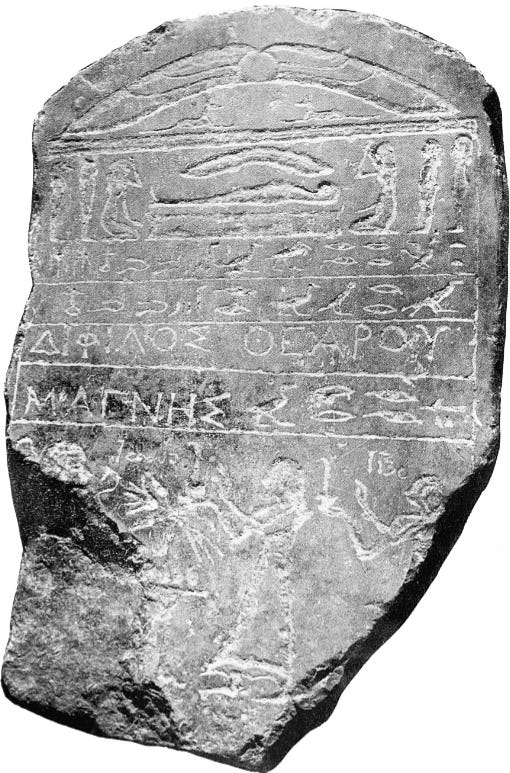On the 25th of June I took part in a talk at Chalke Valley History Festival titled ‘The Ptolemies: When Greeks ruled Egypt’. It was a talk by myself and Toby Wilkinson, chaired by the host of The Ancients podcast, Tristan Hughes.
As I prepared myself for an immensely enjoyable day of history, I found myself returning to the history of Ptolemaic Egypt (late 4th-1st centuries BCE) and the oddities it presents to historians of the Greek world. Here is one such oddity.
When the Greeks ruled Egypt, they did not try to overthrow Egyptian culture or customs. In fact, the secret to their longevity as a ruling dynasty (the longest single dynasty in Egyptian history) was that they didn’t do that! As a result, we often find evidence of blended cultures, where Greek and Egyptian (and sometimes others besides) sit side by side.
Today’s artifact was one I stumbled across in an old text book. It was mentioned in passing as a tombstone (technically this would be called a stele) which not only depicted an Egyptian funeral for a Greek man named Diphilos, but had writing inscribed in both the Greek alphabet and in hieroglyphs!
As can so often be the way, it was hard to track down a photo. In fact, it is perhaps indicative of just how much evidence we have from Egypt that this artifact is rarely mentioned or depicted in history books. But I have tracked one down for us!
Stele of Diphilos

The stone is worn and broken at the bottom but you can make out the images and writing well enough (I find it helps to relax your eyes while looking at it, like a magic eye puzzle).
At the top of the stele we can see some classic Egyptian iconography: two large wings are spread out, beneath which are two small jackals lying down. Below these, the mummy of the deceased hovers above his funeral bed, watched over by a winged disc motif. Neither the disc nor the detail of the two wings are particularly clear any more, it looks more like a boomerang, but other Egyptian examples tell us what it is mean to represent.
The mummy is surrounded by six figures, three on each side, including two kneeling mourners and four divine beings, one of whom, the last on the left, clearly has the head of a jackal - you can tell by the pointy nose.
Beneath this, is a bilingual inscription with carefully drawn lines and surrounded by a frame. Hieroglyphs run across three lines, but are interrupted by a line and a half of ancient Greek text (apologies, my ability to read Greek is much better than my ability to read hieroglyphs). It reads:
Diphilos son of Thearos, from Magnesia
Ancient Magnesia was in Ionia, on the western coast of modern Turkey. So Diphilos was a long way from home!
Below the text there is a broken image of an offering scene: two figures, arms outstretched, come to offer incense burners with stylized flames to a seated figure, probably Diphilos himself.
You can also spy some small letters inscribed near the hands of both human figures. These are in yet another script, demotic which was a more common form of writing in the Egyptian language, but the image is too poor to try and read it and no publications seem to have transcribed what it says.
So, in this one small - oft ignored - artifact, we have a Greek man from Magnesia, whose tombstone depicts Egyptian gods, rituals and languages, alongside a small section of Greek writing to make sure that other Greeks knew who he was. I love it when we find this kind of cultural blending in everyday lives.
As I keep finding myself saying at book talks and events: the ancient world was not one filled with isolated cultural silos, where the Greeks were here, and the Egyptians there. It was one of mixture, of blending and adopting ideas, habits, religions and practices. Not all of them, of course, but enough to influence people like our friend Diphilos here.



